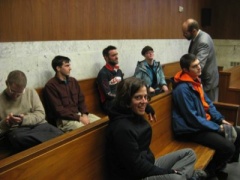
(Photo: Elly Blue)
It’s the third and final day of Phil Sano’s trial for resisting arrest. I’ve been in court all morning, taking notes — which are below — and now the jury is deliberating. There’s no telling when the decision will come.
Some background:
– Our coverage of the initial event
– Our “Phil Sano tasering incident” tag
– Reports from day one of the trial
– Reports from day two of the trial
I’ll post the updates as I edit them, and let you all know as soon as we find out the verdict.
9:01
Waiting to begin. Sergeant Smith comes and sits in the gallery. Gutbezahl [Sano’s lawyer] asks him “Have you seen any police officers around? Oh wait!” ha ha, they both laugh.
Sergeant Smith tells me, “I read your article, I thought it was very accurate.” Well thanks. Did he read the comments? No, he never does, he finds them skewed.
DA is pacing, drawing a new diagram, looking back through the photos.
This morning we’ll hear jury instruction, then closing arguments from both sides, and then the jury will head out to deliberate.
9:16
Judge is reading the jury instructions.
Must make decisions about facts and then apply the law to those facts.
Base your verdicts on the evidence and these instructions. Believe your memory over the lawyers’ statements.
Do not let prejudice play a role, and do not let consideration of the possible sentence affect your verdict.
Jurors must agree unanimously.
Burden is on the state to prove the guilt of the defendant beyond a reasonable doubt. If this can’t be proved the defendant must be innocent.
Sano entered a not guilty plea which means he has denied all the charges.
Definition of resisting arrest: state must prove that Sano intentionally resisted a person he knew to be a peace officer. Resist means to use or threaten to use violence which could injure any person, including oneself.
Question is: did Sano know it was a police officer? And did the officer use unnecessary physical force on a person who was not resisting unlawfully under above definition?

with Diana Spartis looking at camera
(Photo: Sarah Mirk)
10:02
State’s closing argument.
The job of a police officer can include unexpected events. You heard about a highly unexpected event that occurred to these two officers.
The only things you are being asked to consider are the date, venue, and person involved in the case; and did Mr Sano resist arrest?
An arrest means three things: to physically restrain, to tell a person they are being restrained, and taking into custody. The first, physical definition is the one proved here.
Resisting. Violence and physical force are at issue. The risk of injury means to any person including Mr Sano.
You’ve heard two drastically different stories. You must choose which is more believable. But how?
DA has established 8 points of difference between State and Defense cases:
1. Approach to scene (conditions and visibility and of course the badge). Back to Sano’s assertion in traffic court that “it wasn’t that dark.” Sano asserted that he had seen traffic officers in black uniforms before. And that he had looked over at Smith specifically to see if he was a cop. Also: if it was really a surprise attack, why didn’t he try to flee? Inconsistencies in testimony from traffic trial.
2. Commands to stop. Smith said he shouted stop at least three or four times. According to Sano that was from less than 20 feet away. If the officer was lying, why not also lie about saying police too? It would make things so much easier.
3. Contact at bike. This is where you start to consider resisting arrest. Police said that Sano was riding at 5mph and he was pulled by the arm by a 220 pound man. Could Sano’s counter weight have carried them based on inertia into wall. Do you believe this? Or do you believe the officer that there was squaring off, a “vicious” struggle? To believe Mr Sano you must believe that there was no struggle.
4. Contact at wall. Officers testified that the two together had to try to restrain him. Sano testified that this didn’t happen. Smith has never fired Taser in 14 years. Use your common sense. This was not cavalier use of weapon. Does Spartis testimony about Sano not resisting match her statements to media?
5. Contact before Taser. Dialogue between officers about decision to Taser. Sano said this never happened. Lovre contradicts this testimony. He saw both officers pre-tase, saw Sano flail his arms. Lovre’s story is consistent with officers.
6. Cameron Lovre. From across the street saw and identified police officers. Dale was able to identify officers from down the block!
7. Tased on knees while surrendering. “Talk about a stretch of the imagination.” Do you believe Sano or these career police officers?
8. Struggle. Dale testified to a struggle. Defense says that never happened, he was never struggling. Defense says was tased for two minutes, officers say this could not have happened. You have to believe that almost none of the things the officers said happened if you are going to acquit.
DA keeps repeating “It was on. The struggle was on.”
No doubt that Mr Sano suffered pain. It is a tragedy that anyone got hurt. This is one reason never to resist arrest. you must not consider your sympathy for Sano’s suffering or your opinion of the actions of the officers.
The defense will argue with you. But keep in mind that each of these defense positions is completely inconsistent with the testimony of the officers and two disinterested witnesses.
Thank you for your patience. I ask you to return the verdict guilty.
10:35
Defense closing argument.
Defense is giving definition of resisting arrest, and how active resistance differs from passive resistance (which is not a crime).
He will argue that Sano did not recognize the officer.
He will argue that if the jury finds Sano offered any threat of violence it was self defense.
We have had two and a half days of trial over a bike light. It was also a day of the unexpected for Mr Sano.
Sano had been pulled over before, had cooperated.
Sano’s vision is not very good without his glasses.
He just wants to go home after a long day. Some guy said “Hey buddy.” Sano doesn’t want to be hassled. He knows the best thing to do when confronted is just to keep riding, to go about your business.
Points out photo again with the glowing badge — this is not what he saw.
If he’d known it was a police officer he would have stopped and cooperated, as he has done in the past.
Talk about a stretch of the imagination to imagine that an officer can just stop a bike dead in its tracks by sprinting up and grabbing the rider. This was a tackle. The officer’s inertia is moving them towards the wall. Sano loses his glasses and therefore his vision.
How hard would it have been to say “police”? We wouldn’t be here right now. This would have been a citation at worst.
The officer did not act like a police officer.
Sergeant Smith wasn’t intercepting a suspect in an armed robbery. It was a bike light. The officer used excessive force, to warn someone for a bike light.
Smith testified about a huge struggle, but Hoesly was over by the car watching the whole time and didn’t see anything he thought was a big deal.
Their behavior was nothing we would expect from a police officer.
Lovre’s testimony contradicts the police account that they were holding his arms during a violent struggle. He didn’t see them grab his arms and have to restrain him.
Mr Sano was not using his arms for any aggressive purpose. Police say his arms were tense. This is passive, won’t cause injury to anyone.
All points of contact were excessive on part of police. Of course Sano was upset, but Lovre’s testimony shows that he was throwing a tantrum after the pain of the first tasing, not posing a threat.
In Sergeant Smith’s report he says that Mr Sano was just standing there, yelling. He tried to wiggle out of this, but that is what he wrote. And that’s when you get tasered?
Dale and Spartis both show that tasing lasted longer than officers say.
Dale said Sano was writhing around because he was in pain, not out of intention to threaten or resist.
“He was getting juiced.” He had no choice.
Spartis is so horrified by police conduct that she needs to make sure somebody else knows, needed to get police info. She was intimidated and humiliated by the officer’s response.
Definition of resist — if Mr Sano was the wild man that the state reports him to be — neither officer has even a scratch. How can that be if he is so out of control. Why are there no injuries? Use your common sense. If you have this kind of struggle these officers will be injured in some way, however small.
How does Mr Sano benefit from this? Why would he subject himself to this? His history and character show this is not typical for him.
The burden of proof is on the state. State must overcome every reasonable doubt and they cannot. You have a situation that unfolded rapidly, and you have reasonable witnesses showing that there is serious reason to doubt the state’s argument.
Was this a tragic situation? You bet. But here we are. The state has charged Mr Sano with a crime. That is the ultimate power of government, to take away someone’s liberty. That’s why you’re here, because you’re reasonable members of the community. And there is reasonable doubt all over the place. And without a jury who has the courage to come back and say not guilty those rights are meaningless.
10:56
DA’s rebuttal — this is the final argument.
Courage? It takes just as much for a jury member to say the state has met its burden despite sympathy you might have for the defendant.
There is no issue of justification in this case. Just because it’s a bike light he isn’t justified in his conduct. Not a defense in this case.
Officer is authorized to use force to effect his arrest.
Sano’s decision not to stop, and decision to struggle and not comply are the important factors in this charge.
Sano was struggling.
DA is agitated, gesticulating, jumping from point to point.
Officers had no good options. Chose Taser.
Let’s talk about this self defense charge. Defense says this shouldn’t even be applicable if he never did resist.
Officer is justified when using force when officer believes it’s necessary in making an arrest. Not just when threatened.
No mention of surrender on knees in defense closing argument. Maybe that’s because Lovre’s testimony contradicts that. Who do you believe?
Sure, officers could have done a better job. So could Sano. He could have stopped. Not balled his fist. Not struggled, not resisted.
Mr Sano’s story is just a stretch of the imagination too far.
Your verdict of guilty doesn’t mean you are saying Mr Sano did not suffer. It doesn’t mean you’re not going to run out of the courtroom and say “I want the police to do a better job.” Just focus on the one thing. Resisting.
Thanks for your time. Please find that Mr Sano was resisting.
That’s it. The judge tells the jury a few more rules. There is no time limit on their deliberations.
The gallerys about two thirds full, a couple school groups, some Phil supporters, Sarah Mirk from the Merc, other observers.
The jury is ushered out.
The judge reminds the spectators that no reactions are allowed when the verdict is read.

